Built in 1942, Chakulia airport in present day Jharkhand was home to B-29s from the USAAF's 40th Bombardment Group, Abandoned in 1945, it remained a notified area with a ban on construction. There are proposals to revive it in the future. 





Digri Airfield near Uparsolbankati was built in 1942 and used primarily by the RAF's Liberator Squadrons including 355, 357, 358 squadrons. Closed and abandoned in 1945, the runways and aprons are relatively well preserved. 





Armada Road Airfield in Rasgovindpur, Odisha was built in 1942. Home to RAF Hurricane fighters 136 Sqn, 177 Sqn, 607 Sqn. 'Air Fighting Training Unit', formed in February 1943, was also based here. Owned the by the MoD, here are proposals to renovate the airstrip for civil use. 



Baigachi Airfield, northwest of Maniknager, roughly 40km from Calcutta was built in 1941 for the RAF. It was the home of 152 Squadron (Spitfire) for the duration of the war. The airfield was closed in 1946. It is now built up but the runway and aprons are still visible. 



Bishnupur Airfield was used by the U.S. Army Air Force (USAAF) including 10th Air Force B-24 Liberators and 14th Air Force F-5 Lightnings. It was deactivated in 1945 and remained unused since. 



Madhaiganj USAAF Airfield near Durgapur was operationalized in late 1943. Built with two concrete runways, it hosted aircraft from 7th and 12th Bomber Group (B-24 and B-25) and was home base for 426th Night Fighter Squadron (P-61) subsequently deployed to Kuming. Closed 1946. 



Theque airfield was part of RAF Ondal opened in 1943, also a base for USAAF for B-25 bombers. Air Transport Command as a ferry station. Closed in February 1945 and abandoned. Today, it is part of the of Andal Aerotropolis complex including Kazi Nazrul Islam Airport. 

• • •
Missing some Tweet in this thread? You can try to
force a refresh























